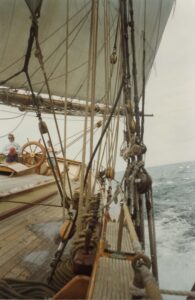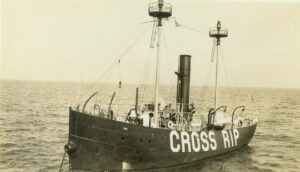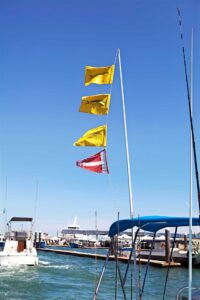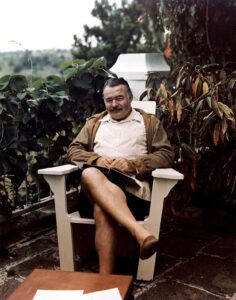Imagine a five-masted wooden schooner hailing from British Columbia that hauled millions of feet of lumber to Australia in the final years of World War I. Carrying a cloud of sail, with a length overall of 246 feet, 44-foot beam and 21-foot draft, she sailed a stately 5 knots, perfect for the dressed lumber trade. During Prohibition, from 1920 to 1933, even at that speed working as a smuggler, she continually eluded the U.S. Coast Guard along the Pacific Coast. According to the Vancouver Maritime Museum, “she delivered more contraband liquor than any other ship.” Her name was Malahat, and she was given the moniker “the Queen of Rum Row.”
Prohibition in the United States made the “manufacture, sale, or transportation of intoxicating liquors within, and the importation thereof into the United States” illegal, but the demand for alcohol never abated since drinking was still allowed. Prohibition began when the Eighteenth Amendment to the United States Constitution went into effect on January 16, 1920. During the Roaring Twenties, speakeasies, bathtub gin, bootlegging, Elliot Ness and the Untouchables became American legends in Chicago. Meanwhile on the Pacific Coast, enterprising Canadians were taking full advantage of the American thirst for Canadian whisky by rum running. Canadians were free to manufacture and export liquor as they wished. Their American customers took possession of these black-market goods offshore and then reentered U.S. territorial waters assuming all the risk, while the Canadians sailed away with a boatload of cash.
Bootlegging and rum running are terms for smuggling alcoholic beverages where their transportation is forbidden by law. The term rum running is more commonly associated with smuggling over water, while bootlegging refers to smuggling over land. It is believed that the term “bootlegging” originated during the American Civil War, when soldiers would sneak liquor into army camps by concealing pint bottles within their boots or beneath their trouser legs. The term “rum running” most likely originated when ships from Bimini in the western Bahamas transported cheap Caribbean rum to Florida speakeasies. Since cheap rum was a low-profit item for rum runners, they soon moved on to smuggling more expensive Canadian whisky. Canadian distillers and seafarers quickly realized that evading duties by moving liquor into the United States illegally had the potential to become a multi-million dollar industry.
During that era, a pro-temperance clergyman called Vancouver “the city of refuge for all the whisky-soaks and booze artists of the whole hemisphere.” Vancouver maintained an active illegal liquor trade with the United States throughout Prohibition. During that time, the city’s longest-serving mayor followed an “open town” policy. Essentially, the rule was that vice crimes such as prostitution, gambling, bootlegging and rum running would be managed, rather than eliminated. Vancouver was the homeport of the schooner Malahat. That vessel could carry up to 84,000 cases of whisky in the hold plus 16,000 cases on deck. That cargo was loaded on in Vancouver and delivered to California once or twice per year. Malahat was just one of many large, slow floating warehouses that stood off the California coast at anchor just outside the 3-mile limit of U.S. jurisdiction. The 3-mile limit became known as the “Rum Line” and the ships waiting just beyond were called “Rum Row.” Smaller, faster “contact boats” then bought and off loaded the contraband liquor and ran it ashore. A case of whisky that cost $15 in Canada could be sold for $120 in San Diego. Some of the fast contact boats could reach speeds of 25 knots and easily outrun U.S. Coast Guard revenue cutters. These fast boats could quickly dock in small coves and transfer their booze to a waiting truck. The Rum Line was extended to a 12-mile limit by an act of Congress in 1924, which made it harder for the smaller and less seaworthy craft to make the trip.
Mother ships, like Malahat, were loaded offshore near Vancouver by intermediate size transfer vessels. After loading thousands of wooden liquor crates aboard the Malahat, the crew would uncrate the bottles and put a dozen of them into burlap sacks stiffened with slats from the crates. These sacks, more manageable than crates, would be transferred to the fast boats off San Francisco or Los Angeles to be brought ashore.
In order for mother ships to evade the Coast Guard during their late-night loading process, ship-to-shore radio communication was essential. Coded shortwave radio messages between smuggling vessels and the homes of the smugglers in Vancouver were maintained. One young woman who helped operate the clandestine shortwave radio ashore was Hazel Stone, sister of Captain Stuart Stone of the Malahat. By day, Hazel worked downtown as a telephone operator. In the evening, she took the streetcar to the western end of the line and made her way to a house where she spent several hours transmitting instructions to the rum runners using their secret codes.
After Prohibition ended in 1933 Malahat returned to carrying lumber, but she couldn’t make a financial success out of her old trade. Eventually her masts were removed and her capacious hull was turned into a log barge, bringing Sitka spruce logs to the sawmills. Malahat foundered in 1944 and was made into a breakwater, not an uncommon end for a sailing ship in those days, even one as notorious as Malahat.
Capt. Jeff Werner has been in the yachting industry for 25 years. In addition to working as a captain on private and charter yachts, both sail and power, he is a certified instructor for the USCG, US Sailing, RYA and the MCA. He is also the Diesel Doctor, helping to keep your yacht’s fuel in optimal condition for peak performance. For more information, call 239-246-6810, or visit MyDieselDoctor.com. All Marinalife members receive a 10% discount on purchases of equipment, products and supplies from Diesel Doctor.
WHERE TO VISIT IN THE VANCOUVER, B.C. AREA
- Vancouver Maritime Museum (1905 Ogden Ave. 604-257-8300)
- Gastown Neighborhood National Historic Site (Northeast end of Downtown 604-682-3868)
- Forbidden Vancouver Walking Tours (207 West Hastings St. 604-227-7570)
- Stanley Park National Historic Site (Borders Downtown 604-681-6728)
- Dr. Sun Yat-Sen Classical Chinese Garden (578 Carrall St. 604-662-3207)
- Burnaby Village Museum (6501 Deer Lake Ave. 604-297-4565)
- Gulf of Georgia Cannery National Historic Site (12138 Fourth Ave. 604-664-9009
- Britannia Shipyards National Historic Site (5180 Westwater Drive 604-238-8050)
WHERE TO DOCK
- Coal Harbour Marina (1525 Coal Harbour Quay, 604-681-2628)
- False Creek Yacht Club (1661 Granville St., 604-682-3292)
- Sewell’s Marina (6409 Bay St., 604-921-3474)
Capt. Jeff Werner has been in the yachting industry for over 25 years. In addition to working as a captain on private and charter yachts, both sail and power, he is a certified instructor for the USCG, US Sailing, RYA and the MCA. He is also the Diesel Doctor, helping to keep your yacht’s fuel in optimal condition for peak performance. For more information, call 239-246-6810, or visit MyDieselDoctor.com. All Marinalife members receive a 10% discount on purchases of equipment, products and supplies from Diesel Doctor.





